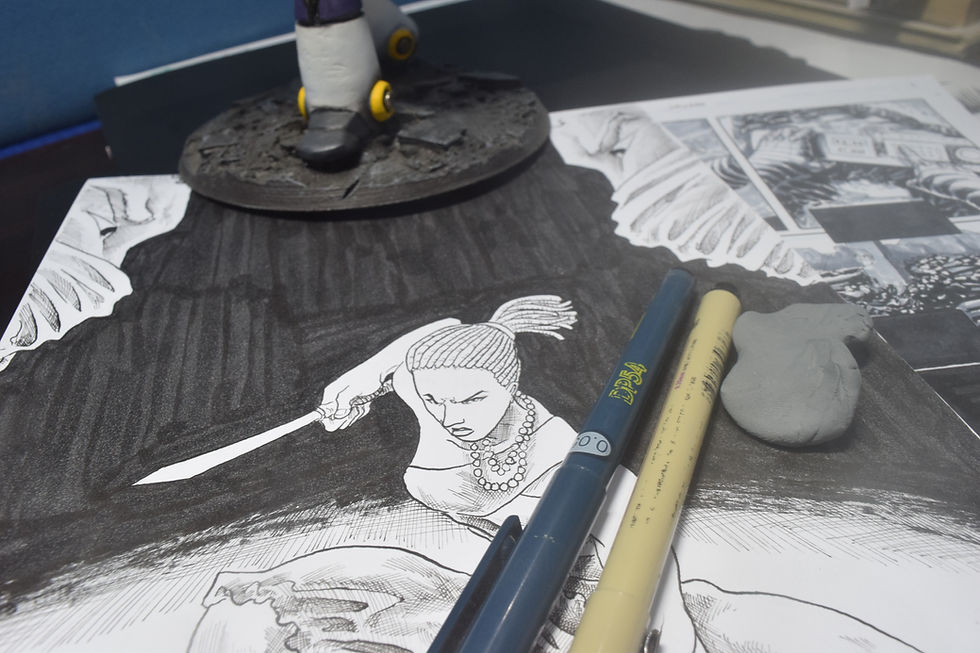The Evolution of Storytelling Through Illustrations
- Arnel

- Sep 8
- 3 min read
Storytelling has been a fundamental part of human culture for thousands of years. From ancient cave paintings to modern digital art, illustrations have played a crucial role in conveying stories visually. This evolution reflects changes in technology, culture, and artistic styles, shaping how stories are told and experienced. In this article, we will explore the fascinating journey of storytelling through illustrations, highlighting key developments and practical insights for creators and enthusiasts alike.
The Origins of Storytelling Illustrations
The earliest known examples of storytelling through images date back to prehistoric times. Cave paintings, such as those found in Lascaux, France, depict scenes of hunting and daily life. These images served as a visual record and a way to communicate stories across generations.
As civilizations advanced, storytelling illustrations became more sophisticated. Ancient Egyptians used hieroglyphics combined with detailed drawings to narrate myths and historical events. Similarly, medieval illuminated manuscripts featured intricate illustrations that complemented religious texts, making stories more accessible and engaging.
Key points about early storytelling illustrations:
Visual storytelling was essential before written language was widespread.
Illustrations helped preserve cultural heritage and shared knowledge.
Artistic styles were influenced by available materials and cultural beliefs.

The Role of Storytelling Illustrations in Modern Media
With the invention of the printing press in the 15th century, storytelling illustrations became more widespread. Books with woodcut prints and engravings allowed stories to reach a broader audience. Over time, illustrated novels, children's books, and newspapers incorporated images to enhance narrative impact.
In the 20th century, the rise of comics revolutionized storytelling illustrations. Comics combine text and images in sequential panels, creating a dynamic and immersive reading experience. This format appeals to all ages and covers diverse genres, from superhero adventures to social commentary.
For those interested in exploring this art form, comics offer a rich platform to understand how illustrations and storytelling merge effectively.
Practical tips for using storytelling illustrations in modern media:
Use images to complement and clarify the text, not just decorate.
Consider the pacing and flow of illustrations to maintain reader engagement.
Experiment with different styles to match the story’s tone and audience.

Digital Transformation and Interactive Storytelling
The digital age has transformed storytelling illustrations dramatically. Digital tools allow artists to create detailed, vibrant images with ease. Moreover, interactive storytelling has emerged, where readers can influence the narrative through choices, animations, or multimedia elements.
Webcomics, graphic novels, and interactive apps are examples of how storytelling illustrations have adapted to new technologies. These formats offer creators more freedom to experiment with layout, color, and interactivity, enhancing the reader’s experience.
Actionable recommendations for digital storytelling illustrations:
Utilize digital software to create high-quality, editable illustrations.
Incorporate interactive elements like clickable panels or animations.
Optimize images for different devices to ensure accessibility.

The Cultural Impact of Storytelling Illustrations
Storytelling illustrations do more than entertain; they shape cultural identity and social understanding. Different cultures have unique visual storytelling traditions that reflect their values and histories. For example, Japanese manga has a distinct style and narrative approach that has influenced global pop culture.
Illustrations can also address social issues, raise awareness, and inspire change. Graphic novels and illustrated journalism have become powerful tools for exploring complex topics in an accessible way.
How to create culturally impactful storytelling illustrations:
Research and respect cultural symbols and storytelling methods.
Use illustrations to highlight diverse perspectives and voices.
Collaborate with communities to ensure authenticity and sensitivity.
Embracing the Future of Storytelling Illustrations
As technology and creativity continue to evolve, so will storytelling illustrations. Emerging trends include augmented reality (AR), virtual reality (VR), and artificial intelligence (AI) in art creation. These innovations promise even more immersive and personalized storytelling experiences.
For creators and enthusiasts, staying informed about new tools and techniques is essential. Embracing experimentation and continuous learning will help keep storytelling illustrations vibrant and relevant.
Final thoughts on advancing storytelling illustrations:
Explore new technologies to expand storytelling possibilities.
Balance innovation with strong narrative fundamentals.
Engage with communities and audiences to understand their evolving needs.
Storytelling through illustrations remains a powerful way to connect, educate, and inspire. By understanding its evolution and applying practical strategies, anyone can contribute to this rich tradition and help shape its future.













Comments